
Kristen Prahl/Getty Images
Crockpots absolutely boomed in popularity in the '70s, soaring from $2 million in sales to $93 million in just four short years. It promised a convenient way to produce comforting, home-cooked meals — and it delivered. Over the years, countless slow cooker recipes have graced kitchens in the U.S.
Some were trendy party appetizers meant to wow guests, while others were humble dinners that filled bellies without breaking the bank. And while many recipes got passed down from generation to generation (and are still popular today), not all of them stood the test of time. As new trends emerged and tastes shifted, many once-loved recipes started to slowly vanish.
While the following old-school crockpot recipes may not be as popular as they once were, there's something deeply satisfying about revisiting them. They remind us of grandma's house, filled with comforting scents that brought everyone together around the table. To many, they're not just old recipes — they're nostalgic dishes that transport you to a simpler time. So, let's take a trip down memory lane and revisit some classic crockpot recipes that grandma used to make.
1. Porcupine meatballs

Elena Vasilchenko/Shutterstock
You may not be surprised that porcupine meatballs have fallen out of popularity. After all, you can't exactly buy porcupine at the grocery store — nor does it sound like an appealing meal. But despite their moniker, porcupine meatballs don't contain any porcupine at all.
Rather, they're similar to traditional meatballs and made with ground beef. The biggest difference is that instead of breadcrumbs, they're made using rice. The rice grains poke out of the meatball, making it resemble — you guessed it — a porcupine. It was popular to cook the meatballs in tomato sauce or tomato soup and serve them with mashed potatoes or noodles.
This tasty treat gained popularity during the Great Depression since the rice allowed families to stretch their ground beef further while still filling their stomachs. The resemblance to a porcupine also turned this affordable and otherwise mundane meal into a fun, whimsical dish, making it a go-to for decades. It remained popular through the 1950s before slowly vanishing from cookbooks and becoming a meal of the past.
2. Grape jelly cocktail smokies
Grape jelly and ... mini sausages? While it may sound like an odd combo, it may also remind you of a similar pair: grape jelly and meatballs. Grape jelly cocktail meatballs became a popular appetizer in the 1960s. The sauce ingredients (just one part grape jelly and one part chili sauce) seemed odd to many even back in the '60s, but proved to be surprisingly delicious. What's more, they were extremely easy to make in bulk, particularly in the slow cooker using frozen meatballs. So, it's no surprise that they quickly became a go-to appetizer to serve at gatherings.
As the '70s rolled around, grape jelly cocktail meatballs were still a favorite. It was around this time that grape jelly cocktail smokies were introduced. These used the same great sauce, but just swapped out meatballs for miniature sausages to add a new twist. Unfortunately, they did not become as iconic as their grape jelly meatball cousins.
3. Beef bourguignon
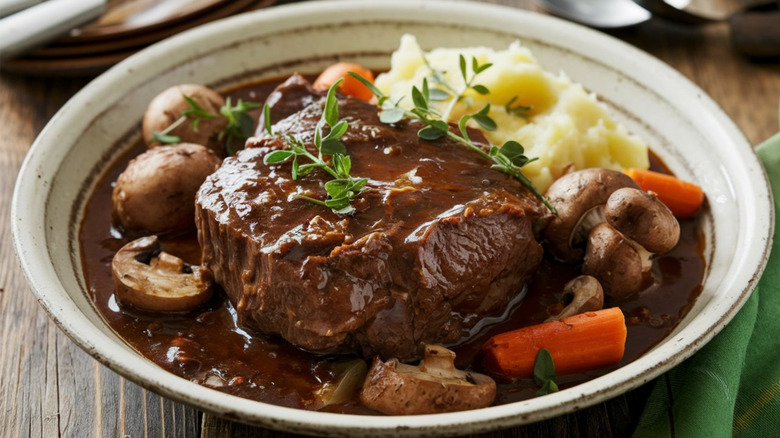
Sham Clicks/Shutterstock
With a fancy name like beef bourguignon, you may think that this dish has a ritzy past. But it was actually a humble dish created by peasants in France in the Middle Ages. Of course, that doesn't mean it isn't impressive. The beef is cooked low and slow until tender with a medley of vegetables (often carrots and onions) and a rich red wine sauce.
It's the kind of dish that warms you from the inside out, and checks all the boxes: filling, nutritious, and delicious. The iconic dish was so flavorful, so hearty, that it stood the test of time and even crossed the Atlantic to become popular in America. In the 1960s, Julia Child made this dish an American staple by including it in her famous cookbook "Mastering the Art of French Cooking" and making it on her PBS show "The French Chef." It was a hit and became a must-make dish for parties and gatherings.
Beef bourguignon is still popular in France, so much so that some think of it as the unofficial national dish. Unfortunately, the same cannot be said for its standing in America. While it'll always have a place in the spotlight thanks to Julia Child, it's now thought of as a vintage slow cooker meal that grandma used to make.
4. Corned beef and cabbage
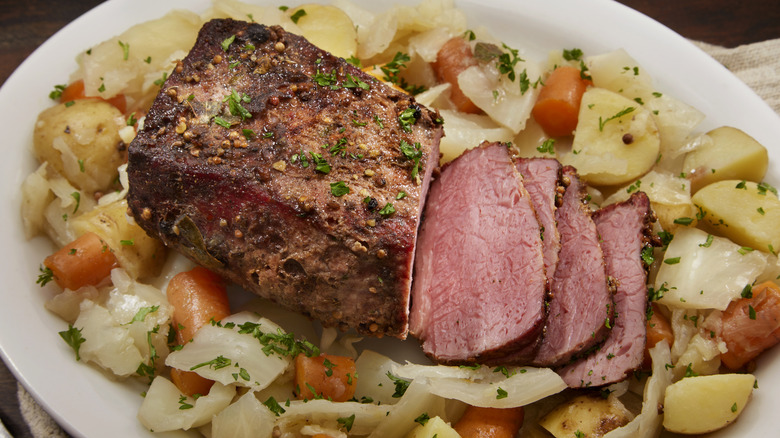
Lauripatterson/Getty Images
Corned beef and cabbage may not have entirely vanished from American kitchens, but it has fallen from its status as a staple meal to being one mainly enjoyed on St. Patrick's Day. Because it's associated with the Irish holiday, it's easy to assume this dish came from Ireland; however, it's actually an Irish-American dish.
Beef was too expensive for many Irish to enjoy, so they mainly ate the more affordable pork, included a salted pork that's similar to bacon. When they immigrated to America, they found the opposite to be true: bacon was too expensive, but beef was affordable. In Jewish delis, they discovered corned beef which tasted similar to the bacon they knew and loved.
Since cabbage was incredibly affordable, it was an accessible vegetable to pair with corned beef. And so, corned beef and cabbage became an easy and cost-effective meal popularized in the Irish-American community. Over the years, it spread and turned into a classic crockpot recipe. Many recipes have made the traditional dish heartier by adding things like carrots, onions, and potatoes. And while it's still enjoyed on St. Patrick's Day, it is no longer the common meal it once was.
5. Salisbury steak

doug m/Shutterstock
Salisbury steak may now be associated with mystery meat school lunches and bland frozen dinners, but it wasn't always that way. The dish has a pretty intriguing history; Dr. James Henry Salisbury believed that minced beef patties were extremely healthy, much better than fruits and vegetables. After testing this theory on Civil War soldiers, he published his findings, and the Salisbury steak started gaining recognition as a healthy and easy-to-make meal.
Then, in the 1950s, canned Salisbury steak and the now-infamous TV dinner made the dish even more accessible. It shot up in popularity. In fact, Salisbury steak was such a popular TV dinner, the two almost became synonymous with each other. It was also found to be a good slow cooker recipe for an easy homemade meal. While Salisbury steaks remained in the spotlight for a while, they have all but vanished from cookbooks.
As the frozen TV dinner started to fall out of popularity in the 1980s, the Salisbury steak went with it. New, more exciting frozen foods took over, making the Salisbury steak a dated option often overlooked. Additionally, our understanding of nutrition has shifted, and the dish is now considered too high in fat and sodium to be thought of as healthy, reducing another appeal it had in its heyday.
6. Swiss steak
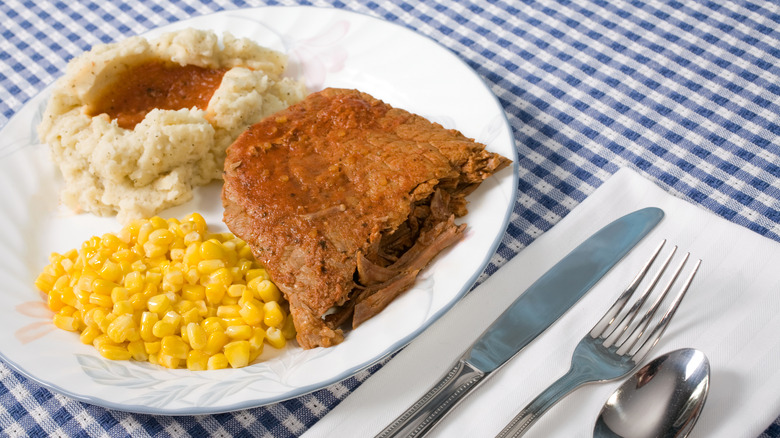
Pickstock/Getty Images
Swiss steak is often confused with Salisbury steak, and while both were popular slow cooker recipes of yesteryear, they do have some major differences. While Salisbury steak is a ground beef patty topped with a beef gravy, swiss steak is an actual steak with a tomato-based sauce. And despite its name, it's not actually from Switzerland. It gets its name because the recipe involves swissing (tenderizing) a tough piece of meat.
And that technique is also why it became so popular. The Great Depression overtook America in the 1930s, and people were looking for any way to cut costs, including opting for the cheaper and tougher cuts of meat. Enter the swiss steak. Not only did the recipe make the meat tender and delicious, but it also called for vegetables to help stretch the meat further.
The low and slow method of cooking swiss steak made it a good crockpot recipe that families came to rely on. However, it's no longer the go-to it was when grandma was in the kitchen. Other, more tender cuts of meat are available for an affordable price. Since they don't need to be tenderized the same way swiss steak did, the dish fell out of use.
7. Venison stew
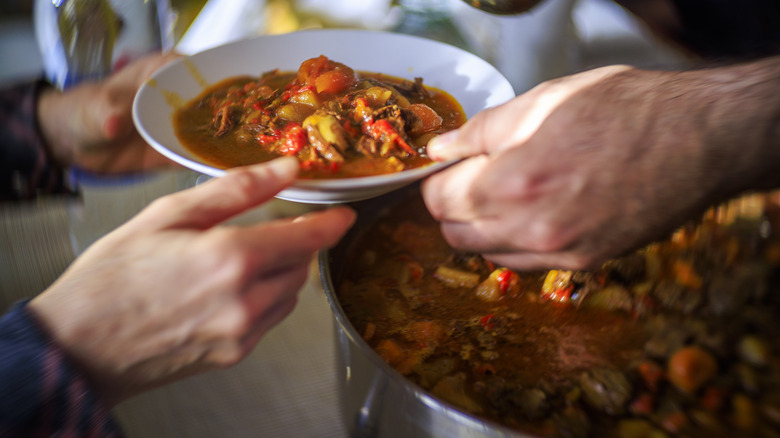
©fitopardo/Getty Images
Venison, or deer meat, was commonly found in two places: unassuming home-cooked meals and luxury restaurants. It's not sold in grocery stores, so the only way to get it is by purchasing it from a specialty food shop or hunting it yourself. The latter made it a common meat for many average American families living in rural areas.
While there are many ways to enjoy venison, slow cooker venison stew was one of the most popular because cooking it low and slow helped to tenderize the non-prime cuts, saving better cuts for other meals. The meat was often cooked in beef broth and accompanied by root vegetables, such as potatoes, carrots, and turnips. So, what happened to venison stew?
Well, hunting numbers increased from 1960 through 1982, where there was a record-breaking 16.7 million hunters in America. Deer are among the most popular animals to hunt, so more and more families were looking for venison recipes to make use of the game they brought home. However, hunting rates started to decline after that 1982 peak, and studies show that non-hunters are less likely to eat wild game. So, while this dish is still enjoyed in hunting families, it's not as prevalent as it was when grandma made it.
8. Steak and Chicken Diane
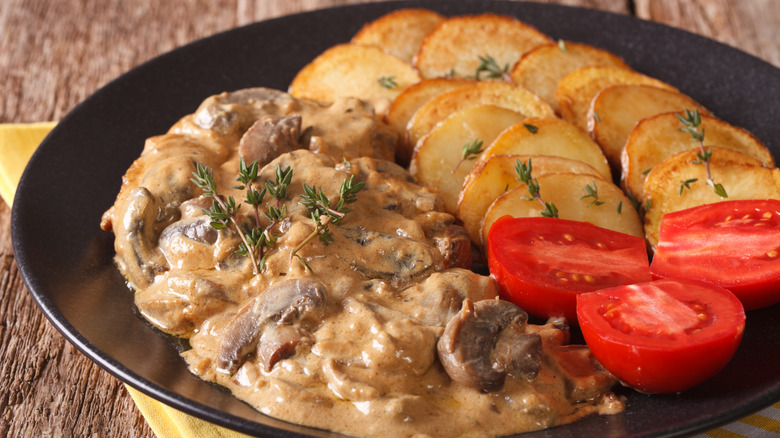
Alleko/Getty Images
Steak Diane was once a popular dish in luxury New York restaurants. Chefs would flambé the sauce tableside, taking it from a delicious meal to a full experience. Chicken Diane was another version. It used a different meat but had the same great sauce made from shallots, mushrooms, and brandy.
Both Steak Diane and Chicken Diane made their way into average American homes where families would slow cook or pan fry them. Attempting a flambé can be intimidating, so it's no surprise that people dropped this step. But flambéing the dish heightens the flavors of the food and brings out the brandy. So, by skipping this step, the dish wasn't quite as good.
Restaurants also phased Steak and Chicken Diane out, but there's no single reason why. Some may have stopped because tableside flambéing is inefficient, and others may have decided to go for more diverse dishes instead to please changing palates. No matter the reason, both Steak and Chicken Diane went from high-end restaurants, to your grandma's crockpot, to a recipe in a cookbook long forgotten.
9. Beef Stroganoff

A. Simpson/Shutterstock
Beef Stroganoff may have been the most popular in America in the '50s and '60s, but it has a much longer history than that. It can be traced back to Russian villagers in the late 1800s, and while the exact origin of the name hasn't been proven, it's thought to be named after the Russian Count Stroganov. Since the beef was cut into small pieces and mixed with noodles, it was an easy way to make a small amount of meat go far. It was then introduced into different parts of the world through immigration, including Western Europe and the U.S., where it became viable as a slow cooker meal.
Interestingly, the dish is vastly different depending on which country you eat it in. For example, it's often served with a tomato sauce in South America and with pickles in Scandinavia. In the U.S., it was often made with cheap ingredients, such as low-quality cuts of meat and canned cream of mushroom soup, and low-quality versions were also often served in school cafeterias. These circumstances, unfortunately, tainted the reputation of this hearty dish, and it became associated more with mid-century convenience cooking than with its rich Russian roots. It fell out of popularity over time and has almost vanished from modern cookbooks.
10. Chicken cacciatore

OlgaBombologna/Shutterstock
Chicken cacciatore, or "hunter's chicken," is a dish consisting of chicken that's been slow cooked in tomatoes, onions, peppers, and a mix of herbs. The exact origin of this dish is contested. While a popular theory is that it is from central Italy during the Renaissance period, there are some issues with that, mainly that tomatoes had not yet made their way to Italy.
But no matter where it started, this recipe eventually made its way into grandmas' slow cookers across the U.S. And it's easy to see why. It's warm, homey, and made with just a few accessible and affordable ingredients. It wasn't a fancy dish, but it didn't need to be. It was a delicious and nutritious dish that made the whole house smell wonderful.
Once a dinnertime staple, chicken cacciatore embodied the idea of slow, comforting meals shared around the table. Unfortunately, this meal has been vanishing from kitchens in the U.S. Many people have started to favor more modern and inventive dishes, which didn't bode well for the classic, simple chicken cacciatore. With no standout "wow factor," restaurants stopped serving it and it fell from the spotlight in homes as well.



